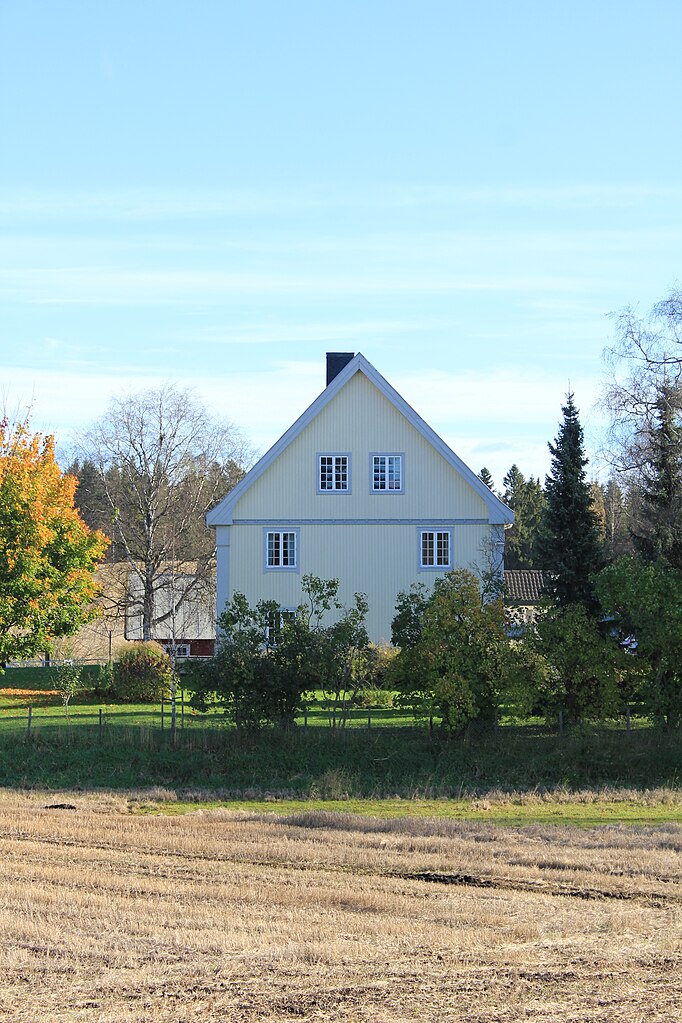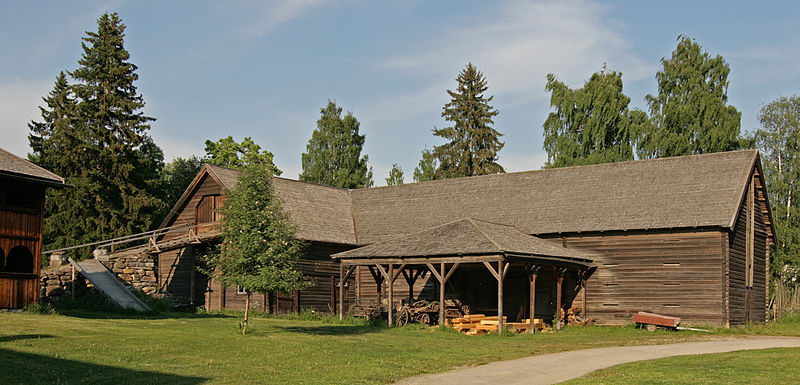The Deep Truth of a Sheltering Roof
The roof plays a primal role in our lives. The most primitive buildings
are nothing but a roof. If the roof is hidden, if its presence cannot be
felt around the building, or if it cannot be used, then people will
lack a fundamental sense of shelter. - Christopher Alexander
 |
| Traditional farmhouse from Løten, Norway |
So, the question is, why not? Why does this taboo exist? What is this
funny business about having to prove you are a modem architect and
having to do something other than a pitched roof? The simplest
explanation is that you have to do these others to prove your membership
in the fraternity of modern architecture. You have to do something more
far out, otherwise people will think you are a simpleton. But I do not
think that is the whole story. I think the more crucial explanation --
very strongly related to what I was talking about last night -- is that
the pitched roof contains a very, very primitive power of feeling. Not a
low pitched, tract house roof, but a beautifully shaped, fully pitched
roof. That kind of roof has a very primitive essence as a shape, which
reaches into a very vulnerable part of you. But the version that is okay
among the architectural fraternity is the one which does not have the
feeling: the weird angle, the butterfly, the asymmetrically steep shed,
etc. -- all the shapes which look interesting but which lack feeling
altogether. The roof issue is a simple example. But I do believe the
history of architecture in the last few decades has been one of
specifically and repeatedly trying to avoid any primitive feeling
whatsoever. Why this has taken place, I don't know. - Christopher Alexander
 |
| This is a
modernists taboo, after 100 years of modernism they still suffer from a
severe phobia for pitched roofs. Could any fancy-full ego-form make
these houses resemble more with the surrounding mountainous landscape?
The picture is from Evanger, Norway. |
Today too many within the "green movement", even
within the permaculture movement, have been bitten by the monsters of
modernity. To be "creative" means in this worldview to contradict what
feels natural, the simplest of all, the pitched roof. Here we are by the
deep truth of a sheltering roof, it's the simplest thing to do in the
whole universe, and thus it's the most natural thing to do. Nature never
makes anything out of creativity, just out of simplicity, and this is
why nature can be so complex. A natural system that did not should
collapse!
 |
| Try to imagine this old Norwegian forest farmhouse with a butterfly roof. It drives you crazy, doesn't it? |
In early times the city itself was intended as an image of the universe –
its form guarantee of the connection between the heavens and the earth,
a picture of a whole and coherent way of life. - Christopher Alexander
 |
| For Christopher Alexander this is wholeness. For Peter Eisenman it is a fake. Photo: Toksave |
What we have not been able to get at yet is that it is possible to
project a totally different cosmology that deals with the feelings of
the self. Alternative views of the world might suggest that it is not
wholeness that will evoke our truest feelings and that it is precisely
the wholeness of the anthropocentric world that it might be the presence
of absence, that is, the nonwhole, the fragment which might produce a
condition that would more closely approximate our innate feelings
today. - Peter Eisenman
Peter Eisenman is a nihilist. In a nihilistic world there is no wholeness, it's just the self. The 20th century became "
The Century of the Self".
The success of consumerism was fulfilled when the industry, through
advanced psychological techniques, made everyone to feel "unique". There
were no more any other "wholeness" than the self, where the world is a
nonwhole expressed through each persons ego. When all peoples needs were
fulfilled, the only way to continue growth was from turning the
economics and our society from needs to desires, and the strongest tool
to use was human desire for uniqueness, the self.
After community was broken and fragmented through the modernists separation and segregation ideals,
the only thing left was individuality, and humans were easily
manipulated to feel "unique" through the products offered them by the
industry. Modernist architects made an unholy alliance with industry to
preach uniqueness through their architecture, to boost consumerism.
Students of architecture are still drilled to keep this wheel rolling.
But not only community fell apart in the last century, even the
perception of God did. From Freud and the psychoanalysis God was
understood as a mother's substitute, and was experienced as suppressed
sexual feelings. Thus, to free the self, the idea of God had to be
abandoned.
Alexander's understanding of God is very different, he sees God as an evolved expression of wholeness.
A world in which there is something to believe in – not a religious
thing – but a believable vision of God as the unity behind all things
which guides us and impels us to act in certain ways. God not conceived
of as a construct of any organized religion, but as a fact of nature and
its wholeness. - Christopher Alexander
With the collapse of community and God there were nothing left than the
self, and thus everything will unavoidably become an expression of the
ego, as there is no higher expression left in the world than the self,
the ego. And this way the whole was destroyed.
Peter Eisenman won the 20th century, not Alexander, and this is no
wonder as both God and community had lost their value when Alexander
entered the stage. For Eisenman there is no reality, a nonwhole, while
for Alexander reality is wholeness, like God. All that the starchitects
buildings say is; Look at me, look at me! While Alexander's buildings
say there is no me, as I'm part of the whole, and the whole is parts
which only purpose is to create strong wholes.
All expressed in Alexander's theory of centers.
Traditional religious texts are founded upon morality stories that help
humanity to see beyond the limitations of human beings existing as
animals or purely subjective beings. But none of this is ever
incorporated into architectural teaching today — which still turns to
the same peculiar handful of (Western) philosophers, relying upon them
to justify “architecture for architecture’s sake”. Judging by how
inhuman its forms are, the driving ideology is purely nihilistic, even
as it serves global capital.
The separation between nihilism and humanism is total and
uncompromising, however. We have to choose very carefully which
philosophers, and which texts to offer students for their reading
assignments. A school cannot abrogate its responsibility by teaching
architecture as a set of self-serving beliefs.
In the twentieth century, architecture became a mass movement under the
influence of leading architects who exploited specific philosophical
texts to support their ideals and to promote themselves. Architecture detached itself from any higher order in human existence, turning away from both nature and from the sacred.
It was the first time in human history that humans began to
intentionally create unnatural structures that are uncomfortable to
inhabit and to experience. - Nikos A. Salingaros & Kenneth G. Masden II
Further architecture up until our time was a generative process,
fundamentally different from the mechanical process practiced today.
This is the process of nature, and if we again want to become part of
nature, and what more can we aspire for, we need to return to this
process.
For example the temporal priority issue is very different from current
practice. If someone has built something, then the person who comes
later must legally pay attention to what is there and respond to it.
This process is akin to weaving, that is, the next act always responds
to the previous act and completes it. Compared to current law, in most
US cities, that provides each person the same rights, regardless of the
temporal sequence. Thus each project, and each lot, becomes an isolated
island, with no significant relation to the whole, and is unable, for
the same reason, to intensify the context in which it is located. A
fundamental principle that was explicit in traditional generative
processes is that a new construction shall not do harm to its
surroundings. This is in reverse to the current approach of zoning law
that is followed in most US cities, which implicitly accepts that each
case is different, by applying strict geometrical regulations blindly.
Another important practice in traditional generative processes is
negotiating decisions that may cause harm to the surroundings and the
means to avoid them. - Besim S. Hakim
I beg everyone planning for a
pocket neighborhood,
ecovillage or
village town,
to make it an expression of Alexander's wholeness and not Eisenman's
ego. The sheltering roof is a natural part of this wholeness.
Please read the legendary 1982 debate between Christopher Alexander and
Peter Eisenman to get a better understanding of these two diametrical
different worldviews, you find it
here.
In other words, the order I was sketching out last night is ultimately,
fundamentally an order produced by centers or wholes which are
reinforcing each other and creating each other. Now, if all of that is
so, then the pitched roof would simply come about as a consequence of
all that -- not as an antecedent. It would turn out that, in
circumstances where one is putting a roof on a building, in the absence
of other very strong forces that are forcing you to do something
different, that is the most natural and simple roof to do. And,
therefore, that kind of order would tend to reappear -- of course, in a
completely different, modern technological style -- simply because that
is the nature of order, not because of a romantic harkening back to past
years. You probably understand this. - Christopher Alexander
 |
| If
you could asked the traditional farmer why he put on this kind of a
"boring" pitched roof on his house, he would just had looked silly at
you. And of course, you were silly, utterly silly. |
I live in the boreal region, and here the warmth and embracing of a
sheltering roof is of extraordinary importance to endure the dark, cold
winters. Like a grouse sheltering her chickens under her warm wings.
Just the sight of a sheltering roof makes me feel warm inside. No other
roof can do that!
 |
| The sheltering roof is to be found all over the world of all times, it's universal and inherent to human biophilia. Here from an old Japanese village. Photo: Yosemite |
 |
| A pair of
wings of a grouse is like a sheltering roof. I hope you can both see and
feel the similarity? It's like the embracing of a woman, the
sensitivity of a poem. |
What constitutes the charm to the eye of the old-fashioned country barn
but it's immense roof - a slope of grey shingle exposed to the weather
like the side of a hill, and by its amplitude suggesting a bounty that
warms the heart. Many of the old farmhouses, too, were modeled on the
same generous scale, and at a distance little was visible but their
great sloping roofs. They covered their inmates as a hen covered her
brood, and are touching pictures of the domestic spirit in its simpler
forms. - John Burroughs, Signs and Seasons, New York: Houghton Mifflin, 1914, p. 252
This article started with a quota from
A Pattern Language, it's now time to go back to this book of wisdom to find out more about what it has to say about our topic.
Pattern 117, Sheltering Roof (the original text includes illustrations and wonderful pictures):
This sheltering function cannot be created by a pitched roof, or large
roof, which is merely added to the top of an existing structure. The
roof itself only shelters if it contains, embraces, covers, surrounds
the process of living. This means very simply, that the roof must not
only be large and visible, but must also include living quarters within
its volume, not only underneath it. - A Pattern Language, page 570
We believe that this connection between the geometry of roofs, and their
capacity to provide psychological shelter, can be put
on empirical grounds: first, there is a kind of evidence which shows
that both children and adults naturally incline toward the sheltering
roofs, almost as if they had archetypal properties. - A Pattern Language, page 571
The space under or on the roof must be useful space that people come in
contact with daily. The whole feeling of shelter comes from the fact
that the roof surrounds people at the same time that it covers them.
Seen from afar, the roof of the building must be made to form a massive
part of the building. When you see the building, you see the roof. This
is perhaps the most dramatic feature of a strong, sheltering roof. - A Pattern Language, page 572
And a sheltering roof must be placed so that one can touch it - touch it
from outside. If it is pitched or vaulted, some part of the roof must
come down low to the ground, just in place where there is a path, so
that it becomes a natural thing to touch the roof edge as you pass it. - A Pattern Language, page 572-573
Therefore:
Slope the roof or make a vault of it, make its entire surface
visible, and bring the eaves of the roof down low, as low as 6'0" or
6'6" at places like the entrance, where people pause. Build the top
story of each wing right into the roof, so that the roof does not only
cover it, but actually surrounds it. - A Pattern Language, page 573
 |
| Another
Japanese house with a thick thatched roof, embracing and warming its
inhabitants. These houses are as much a part of nature as the mountains
glimpsed in the background. This because of their simplicity, it's
completely ego-free, like nature is. Photo: Yosemite |
Some permaculturists are eager to cover every roof in the world with hard, smooth and shiny solar cell panels.
I will advice to think twice!
Without respecting our sensory system and its need for natural
materials and geometry, a society in balance with nature cannot be
achieved.
Architecture connects to the human consciousness via the smallest
details, whether those buildings are in a traditional, or a Modernist
style. The psychological need for detail at the smallest perceivable
scale is illustrated by the widespread use of natural surfaces such as
polished wood and stone, whenever it is economically feasible. Such
surfaces provide an emotional connection to details well below 1 mm in
size. The eye actually perceives the natural structures that
characterize real wood or marble, even though they are at the limit of
visual perception. One is not easily fooled by Formica even at a
distance.
It is possible to highlight the connection between an observer and the
microscopic structure of materials, which is obtained via the scaling
hierarchy. From the human scale on down, there exists an infinite
hierarchy of decreasing scales connecting us to the basic components of
matter. This downward scaling links man to the microcosm, and is just as
important as the more obvious connection to the larger scales. We
establish a strong connection to materials that have a clear
hierarchical microstructure, but not to featureless materials that are
either amorphous, transparent, or highly reflective.
Materials lacking in natural qualities often result in unresponsive
surfaces. That is in part due to the ways they are employed. Modern
materials, which as a rule have no ordered microstructure, can establish
an emotional connection only through the scaling hierarchy. One needs
to differentiate surfaces and to articulate subdivisions much more than
with natural materials. That might involve combining matte with shiny
materials, and re-introducing detail and color. We do not advocate
copying natural materials, but rather finding expressive means to
utilize each material's own intrinsic capabilities. - Nikos A. Salingaros
 |
| Clay stone roof tiles with lichen, a material that ages with dignity |
 |
| Norwegian wooden roof tiles |
 |
| A slate roof covering |
No human made materials can replace the
biophilic effect
of natural materials. As the roof is such a fundamental part of a house
and our lives, we should be careful not to damage this effect, as this
can easily be damaging for our own well-being.
 |
| The most primitive buildings are nothing
but a roof. If the roof is hidden, if its presence cannot be felt around
the building, or if it cannot be used, then people will lack a
fundamental sense of shelter. - Pattern 117, Sheltering Roof. Photo: Muhammad Mahdi Karim |

















No comments:
Post a Comment